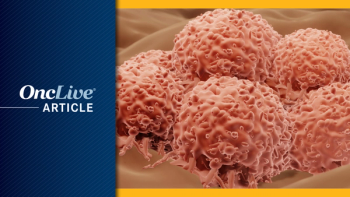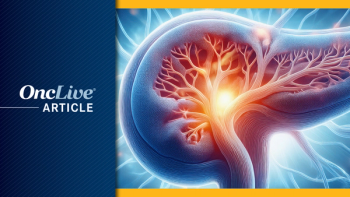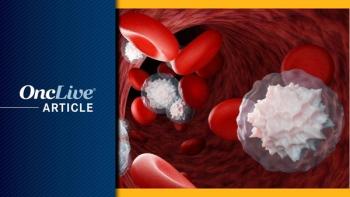
Promising Data for Treatment of Myelofibrosis Emerges With Pelabresib and Ruxolitinib Combination
John Mascarenhas, MD, discussed the effect of the data from MANIFEST on the treatment landscape and the future of adding active agents to ruxolitinib for treatment of myelofibrosis.
Responses produced in patients with myelofibrosis who received pelabresib (CPI-0610) in combination with ruxolitinib (Jakafi) were durable beyond week 24 according to data from the phase 2 MANIFEST trial (NCT02158858) presented at the EHA Congress 2022.
At week 24, 68% (95% CI, 57%-78%) of patients in arm 3 (n = 84) achieved a reduction in spleen volume of at least 35% (SVR35) and 56% (95% CI, 45%-67%) of patients experienced a 50% or greater reduction in total symptom score (TSS) at week 24 (median change: –59%). Further, 20% of patients in arm 2 (n = 86) experienced SVR35 by week 24 and 37% achieved TSS50 (median change: –47%). The ongoing phase 3 MANIFEST-2 trial (NCT04603495) will expand on the data.
“I think the data are exciting because they continue to demonstrate over a number of patients, over a number of centers, the benefit of combining these 2 therapies,” John Mascarenhas, MD, explained. “We’ve done analysis that showed whether you separate patients by their prognostic score, by their molecular profile, etc, the benefit seems to be across these patients’ subgroups. It really provides additional confidence in moving this therapy into the phase 3 setting.”
In an interview with OncLive®, Mascarenhas, director of the Center of Excellence for Blood Cancers and Myeloid Disorders at Mount Sinai, discussed the effect of the data from MANIFEST on the treatment landscape and the future of adding active agents to ruxolitinib for treatment of myelofibrosis.
Please share the rationale of MANIFEST and what investigators observed for myelofibrosis.
MANIFEST is a phase 2 study of pelabresib, an oral BET inhibitor, either alone in patients who have failed ruxolitinib, in combination [for] patients who have a suboptimal response to ruxolitinib, or in combination with ruxolitinib [for] patients who are JAK-inhibitor naïve. This trial is predicated on data that were generated from 2 independent laboratories…demonstrating activity of BET inhibition which is a form of epigenetic regulation and gene transcription particularly focused on down regulation of NF-κB regulated genes and the pro-inflammatory cytokine expression of those genes in patients with myelofibrosis.
The combination of ruxolitinib and pelabresib in murine modeling was synergistic in improving aspects of the disease in mice that are generated to have myelofibrosis.
The data that we [presented] at EHA this year is an update on that MANIFEST phase 2 data demonstrating continued success in terms of spleen and symptom benefit. [With the] combination [in arm 3 we saw] 68%, spleen volume reduction of 35% or greater, and symptom improvement of [approximately] 56% TSS [of] 50% or better. [There is a] very significant spleen and symptom benefit with the combination of these 2 drugs. If one looks back, historically at single agent ruxolitinib, this is a far deeper [response] and a greater number of patients [who] are hitting these endpoints.
Similarly, in arm 2 we also looked at spleen and symptom benefit in patients who had a suboptimal response to ruxolitinib by combining it with pelabresib, which is given at 125 mg—14 days on, 7 days off—in a 21-day cycles, and the SVR35 was [approximately] 30% in that arm, and the TSS50 was 37%. This demonstrated the ability to rescue loss of response or inadequate response in patients already on ruxolitinib.
This response was improved in many patients, particularly in arm 3, over time and had minimal myelosuppression. In arm 3, for example, grade 3 anemia was approximately 34% and thrombocytopenia was approximately 12%. [The events are] fairly predictable in their onset.
[Pelabresib is] a very well tolerated drug. Most importantly, we saw [approximately] one-third of patients have a reduction of at least 1 grade of fibrosis in their bone marrow, even as early as 24 weeks. [There was also] significant reduction in inflammatory cytokines, as well as bone marrow histopathologic changes as it relates to not just reticulin fibrosis, but atypia megakaryocytes and distance between the megakaryocytes suggesting that we’re having an effect in the bone marrow on megakaryopoiesis, which is also an important hallmark of myelofibrosis.
This all informed and endorsed the MANIFEST-2 study which is the ongoing randomized phase 3 study in patients who are JAK-inhibitor naïve combining ruxolitinib and pelabresib and comparing it [with] ruxolitinib and placebo in patients with intermediate and high-risk myelofibrosis who have measurable spleen and symptom burden. The primary end point of this study is to demonstrate superiority with respect to spleen volume reduction and then symptom improvement but also duration of response as a key secondary end point.
Please expand on the patient population that was observed in this study.
[MANIFEST had 3 groups of patients. [The first group included] patients who had been on ruxolitinib who had failed and needed a second line of therapy to address spleen and symptom burden, or who were transfusion dependent. That was a stratified group [and] those [who] were transfusion dependent had a primary end point of transfusion independence. Patients in arm 2 [had prior] ruxolitinib [but] were not [eliciting] full benefit, had lost some degree of benefit from spleen or symptom burden, or were transfusion dependent. [Those in] arm 3 ultimately went on to the phase 3 study design; [these were] patients [who] were JAK-inhibitor naïve and were receiving ruxolitinib plus pelabresib as a frontline therapy. I think that’s probably the first trial of its kind, combining ruxolitinib plus another agent in the upfront setting, and now that’s [setting] the stage for a number of different trials [which] are evaluating active agents such as navitoclax…and parsaclisib, to name a few, in combination with ruxolitinib, both in the upfront and in the relapsed refractory setting.
Are there any data that you wanted to highlight regarding safety?
[Pelabresib] seems to be well tolerated, there is some degree of thrombocytopenia that is not significant and usually rebounds because [the regimen is given] 2 weeks on and 1 week off. For the most part, one can continue dosing pelabresib with minimal need to stop or dose reduce the drug and that’s important when trying to treat patients particularly [those] with chronic diseases. We did see some [gastrointestinal] GI toxicity which was anticipated in [approximately] one-third of the patients that was mostly low grade and rarely led to study discontinuation or dose modification.
What next steps will be taken with this research and specifically, where will the MANIFEST-2 study take this research?
MANIFEST-2 is designed to confirm what the MANIFEST study has implied, that there is additional benefit of combining pelabresib to ruxolitinib; MANIFEST-2 will confirm that in a randomized phase 3 setting that is double blinded, placebo controlled. It’s a rigid study in the sense that it should be able to provide us with concrete controlled evidence for benefit.
I think it’s important to keep in mind that although the primary end point of the MANIFEST-2 is based on spleen volume response rate and total symptom score [which is] a key secondary end point, one of the most important end points for a clinician and a patient is going to be the duration of response. The ability to prolong the benefit of a JAK inhibitor is an important aspect of this trial. When know that with single agent ruxolitinib, the median time to discontinuation is [approximately] 3 years. I’m hoping that by adding pelabresib we don’t simply see a greater number of patients getting a SVR35 or a deeper SVR35, I’m hoping that we also see a longer duration of response and benefit because we know that once patients discontinued ruxolitinibunfortunately, the outcomes in survival are poor.
Overall, what would you like your colleagues to take away from this research?
The main exciting message is that the field is moving forward. It’s about time and overdue. For a long time in myelofibrosis, we’ve been focused on single-agent therapies and then sequencing single-agent therapies and that’s not the paradigm that is effective in most of malignant hematology. Looking at multiple myeloma, lymphoma, leukemia, they’ve all moved on to very effectively to combination therapies to improve upon responses and duration of responses and survival. I’m very hopeful that we will see that now in myelofibrosis where we take differing mechanism of action therapeutics, hopefully without overlapping toxicities, and get deeper more prolonged responses and improve both event-free survival and overall survival in patients.
Reference
- Mascarenhas J, Kremyanskaya M, Patriarca A, et al. BET inhibitor pelabresib (CPI-0610) combined with ruxolitinib in patients with myelofibrosis – JAK inhibitor-naïve or with suboptimal response to ruxolitinib – preliminary data from the MANIFEST study. HemaSphere. 2022;6:99-100. doi:10.1097/01.HS9.0000843684.97625.7e

























































































